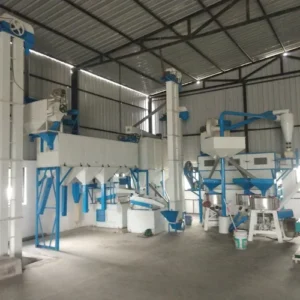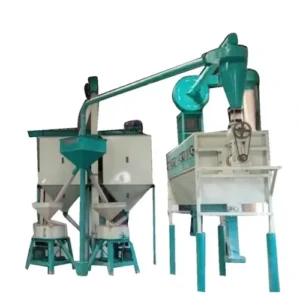Food Grains, Nut, Flour & Spices Processing Machines
-
75 HP Mild Steel Fully Automatic Flour Mill Plant
Capacity 1000 kg/hrMotor Power 75 HPOperation Mode Automatic₹1,450,000.0075 HP Mild Steel Fully Automatic Flour Mill Plant
₹1,450,000.00 -
Automatic Flour Mill, 30 HP
Operation Mode AutomaticPower Rating 30 HPCertification MSME₹800,000.00Automatic Flour Mill, 30 HP
₹800,000.00 -
37hp Automatic Flour Mill Plant
Capacity 250kg/hMotor Power 37hpPower Consumption 12kW₹730,000.0037hp Automatic Flour Mill Plant
₹730,000.00 -
Industrial Wheat Flour Mill Plant
Operation Mode AutomaticMaterial of Construction Mild SteelElectricity Connection Three Phase₹1,006,720.00Industrial Wheat Flour Mill Plant
₹1,006,720.00
Food Grains, Nut, Flour & Spices Processing Machines: A Complete Guide
Introduction
Food processing is an essential industry that transforms raw agricultural products into consumable food items. The processing of food grains, nuts, flour, and spices requires specialized machinery to ensure efficiency, consistency, and high-quality output. Whether for sorting, cleaning, milling, grinding, roasting, or packaging, modern food processing machines play a crucial role in large-scale and small-scale food production.
This comprehensive guide will cover everything you need to know about food grains, nuts, flour, and spices processing machines, including types, working principles, applications, benefits, maintenance tips, and buying considerations.
1. What Are Food Grains, Nut, Flour & Spices Processing Machines?
Food processing machines are designed to clean, sort, grind, mill, roast, and package food grains, nuts, flour, and spices. These machines enhance efficiency, hygiene, and productivity in food manufacturing industries.
1.1 Importance of Food Processing Machines
-
Enhances food safety by removing impurities and contaminants
-
Improves shelf life through proper processing and packaging
-
Ensures uniform quality for commercial food production
-
Reduces manual labor and increases production efficiency
1.2 Industries That Use These Machines
-
Agriculture and Farming – Processing raw grains and nuts
-
Flour Milling – Turning grains into flour
-
Spice Processing – Grinding and packaging spices
-
Food Packaging Industry – Ensuring proper storage and distribution
2. Types of Food Processing Machines for Grains, Nuts, Flour & Spices
2.1 Grain Processing Machines
These machines handle the cleaning, sorting, dehusking, and milling of food grains such as wheat, rice, corn, barley, and millet.
(a) Grain Cleaning Machines
-
Vibrating Separator – Removes dust, stones, and foreign particles
-
Destoner Machine – Eliminates stones from grains
-
Gravity Separator – Separates grains based on density
(b) Grain Milling Machines
-
Roller Mill – Used in flour milling for crushing grains
-
Hammer Mill – Pulverizes grains into fine powder
-
Rice Mill – Removes husk and polishes rice
(c) Grain Sorting Machines
-
Color Sorter Machine – Uses optical technology to remove defective grains
-
Grain Grading Machine – Sorts grains by size and weight
2.2 Nut Processing Machines
Nut processing includes dehusking, roasting, grinding, and oil extraction for nuts such as almonds, peanuts, cashews, and walnuts.
(a) Nut Cleaning and Sorting Machines
-
Sheller Machines – Removes hard shells from nuts
-
Nut Grading Machine – Sorts nuts based on size
(b) Nut Roasting and Grinding Machines
-
Nut Roasters – Roasts nuts at controlled temperatures
-
Nut Grinder – Grinds roasted nuts into pastes or powders
(c) Nut Oil Extraction Machines
-
Cold Press Oil Extractor – Extracts oil without heat for pure quality
-
Hydraulic Press Machine – Used for large-scale oil extraction
2.3 Flour Milling Machines
Flour production involves grinding grains into fine powder using advanced milling technology.
(a) Wheat and Maize Milling Machines
-
Stone Mill – Traditional method for making high-quality flour
-
Roller Flour Mill – High-speed milling for bulk flour production
(b) Flour Sieving and Packaging Machines
-
Rotary Sifter – Removes impurities from flour
-
Flour Packaging Machine – Ensures hygienic and airtight packaging
2.4 Spice Processing Machines
Spices like turmeric, pepper, cinnamon, cloves, and chili require grinding, blending, and packaging for commercial use.
(a) Spice Cleaning Machines
-
Air Classifier Separator – Removes dust and husk from spices
(b) Spice Grinding Machines
-
Pulverizer Machine – Grinds spices into fine powder
-
Hammer Mill – Suitable for coarse grinding
(c) Spice Blending and Packaging Machines
-
Spice Mixer – Uniformly blends spice powders
-
Vacuum Packaging Machine – Extends shelf life of packaged spices
3. Working Principles of Food Processing Machines
Each category of food processing machines operates on different principles to achieve the desired results.
3.1 Cleaning and Sorting Principles
-
Vibration and Gravity Separation – Removes impurities from grains and nuts
-
Optical Sorting – Uses cameras to detect defective food items
3.2 Grinding and Milling Principles
-
Impact Grinding (Hammer Mill) – High-speed blades crush food items
-
Shearing and Rolling (Roller Mills) – Cracks grains for flour production
3.3 Roasting and Heating Principles
-
Convection Heating (Nut Roasters) – Evenly distributes heat to roast nuts
-
Infrared Heating (Spices Roasters) – Retains flavor and color in spices
3.4 Oil Extraction Principles
-
Cold Press Extraction – Uses pressure to extract oil without heat
-
Solvent Extraction – Uses chemicals to maximize oil yield
4. Applications of Food Processing Machines
These machines are used in a variety of industries for different applications.
| Industry | Applications |
|---|---|
| Agriculture | Cleaning and sorting grains and nuts |
| Flour Milling | Grinding wheat, maize, and rice into flour |
| Food Industry | Spice processing for commercial sale |
| Oil Production | Extracting oils from nuts and seeds |
| Packaging | Sealing and labeling food products |
5. Benefits of Using Food Processing Machines
5.1 Improved Efficiency and Productivity
-
Reduces manual labor and increases output
-
Allows continuous production with minimal downtime
5.2 Enhanced Food Safety and Hygiene
-
Removes impurities and contaminants
-
Ensures food meets quality and safety standards
5.3 Cost Savings and Profitability
-
Reduces waste and spoilage
-
Optimized energy and water usage lowers operating costs
5.4 Customization and Versatility
-
Machines can be adjusted for different grain, nut, flour, and spice types
-
Compatible with automated production lines
6. Factors to Consider When Buying Food Processing Machines
6.1 Machine Capacity and Output
-
Choose based on production requirements (small-scale vs. industrial use)
6.2 Energy Efficiency and Operating Costs
-
Opt for energy-saving models to reduce electricity and fuel consumption
6.3 Material and Build Quality
-
Machines should be made of stainless steel for hygiene and durability
6.4 Automation and Control Features
-
Modern machines include PLC control, touchscreens, and IoT connectivity
6.5 Maintenance and Spare Parts Availability
-
Select machines with easy maintenance and readily available spare parts
7. Maintenance and Safety Tips
7.1 Routine Cleaning and Inspection
-
Regularly clean grinders, rollers, and hoppers to prevent contamination
7.2 Lubrication of Moving Parts
-
Keeps machines running smoothly and prevents breakdowns
7.3 Operator Training and Safety Measures
-
Ensure workers follow safety protocols and wear protective gear
8. Future Trends in Food Processing Machines
8.1 Smart and IoT-Enabled Machines
-
Real-time monitoring and predictive maintenance using IoT
8.2 Eco-Friendly and Energy-Efficient Designs
-
Machines with low emissions and reduced energy consumption
8.3 AI and Automation
-
Artificial intelligence to optimize sorting and milling processes
Conclusion
Food grains, nut, flour, and spice processing machines play a vital role in modern food production. Investing in high-quality food processing machines ensures greater efficiency, hygiene, and profitability for businesses.
Looking for the best food processing machines? Explore leading brands and models to find the perfect solution for your processing needs! 🚀




